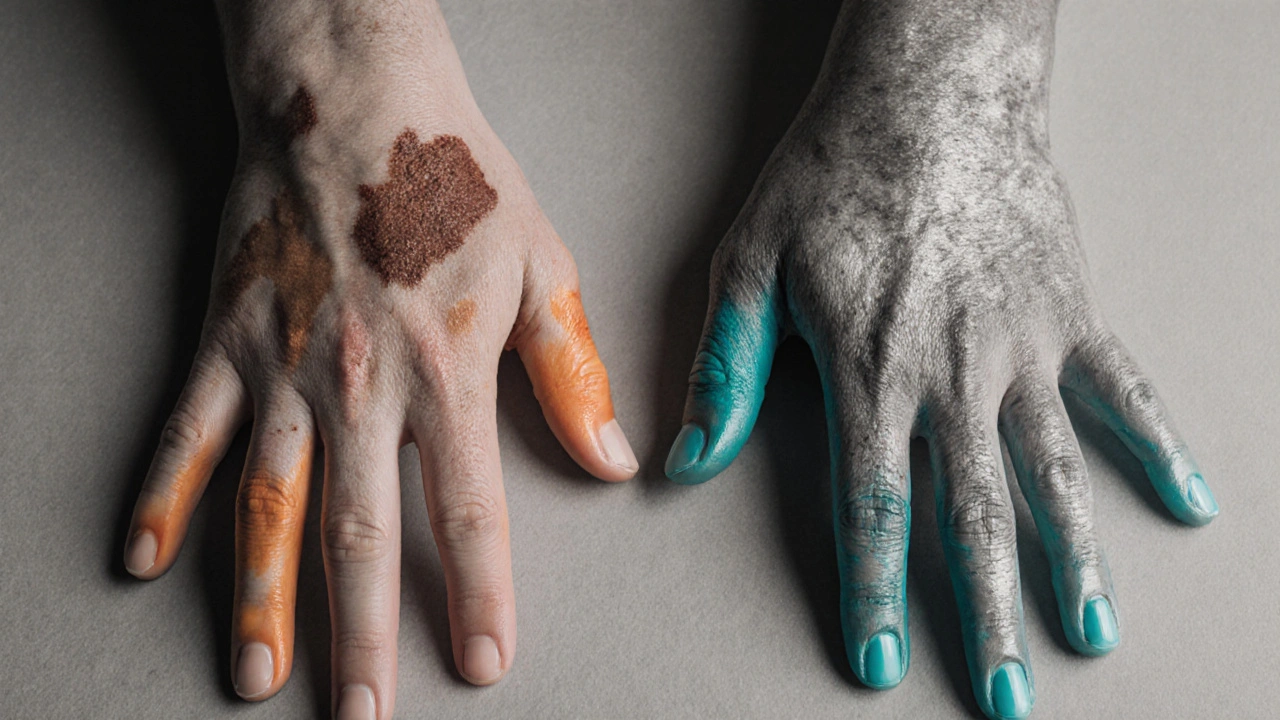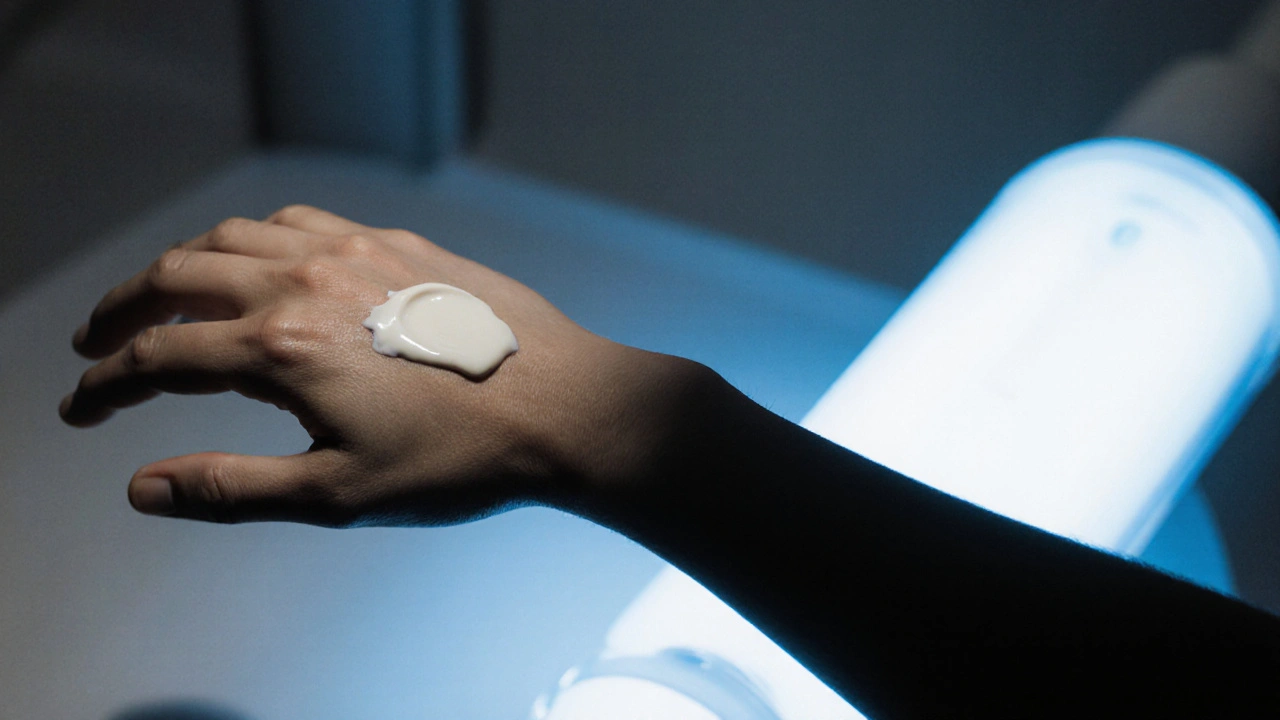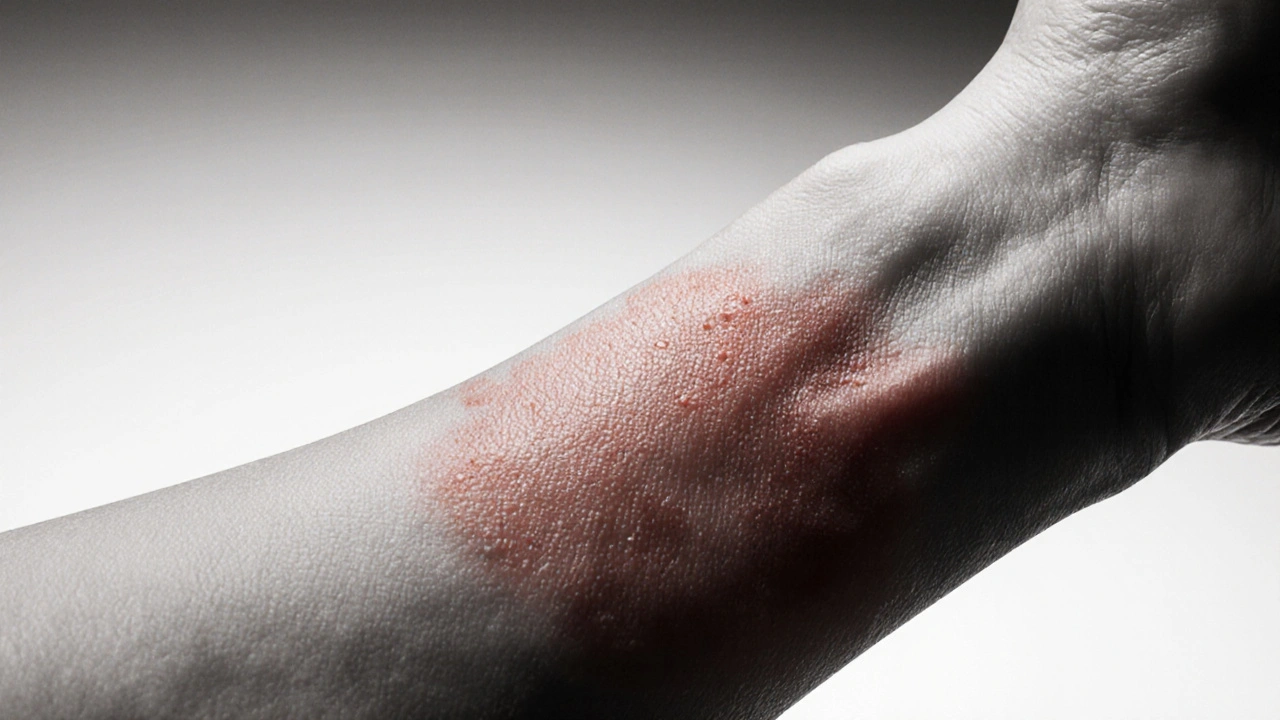Skin Condition Assessment Tool
This interactive tool helps identify potential skin conditions based on your symptoms and risk factors. Understanding connections between dermatitis and psoriasis can lead to earlier detection and more effective treatment strategies.
Symptom Assessment
When you hear dermatitis, you probably picture itchy, red patches that just won’t quit. What’s less obvious is how often this condition overlaps with other skin disorders, especially psoriasis. Understanding the overlap can help you spot early signs, choose better treatments, and avoid surprises down the road.
What "Dermatitis" Really Means
Dermatitis is a broad umbrella term for skin inflammation that can be triggered by genetics, allergens, irritants, or a compromised skin barrier. Common symptoms include redness, swelling, itching, and sometimes oozing or crusting. The term covers several sub‑types, each with its own triggers and treatment nuances.
Major Types of Dermatitis and How They Differ
- Atopic dermatitis (often called eczema) is linked to a family history of allergies and a leaky skin barrier.
- Contact dermatitis occurs after direct contact with irritants (like chemicals) or allergens (like nickel).
- Seborrheic dermatitis shows up as flaky, oily patches on the scalp, eyebrows, or around the nose.
- Dyshidrotic dermatitis produces itchy blisters on the hands and feet.
Each type shares the core feature-skin inflammation-but the triggers, locations, and long‑term outlook can vary a lot.
Psoriasis: A Close Cousin
Psoriasis is an autoimmune disease where the immune system speeds up skin cell growth, creating thick, silvery scales. While it looks different from typical eczema, the two share a common thread: both involve an overactive immune response and chronic inflammation.
Studies from 2023‑2024 show that up to 30% of people with psoriasis also develop some form of dermatitis, and vice‑versa. The overlap isn’t random; it points to shared genetic pathways and a common problem with the skin’s barrier function.
Why Do These Conditions Co‑occur?
Three main factors link dermatitis to psoriasis and other skin disorders:
- Genetics: Certain gene variants, likeIL23R andFLG, raise the risk for both eczema and psoriasis. Researchers at the University of Manchester found that people carrying theFLG loss‑of‑function mutation were twice as likely to develop a second skin condition.
- Immune System Crosstalk: Both conditions involve cytokines such asIL‑17,IL‑22, andTNF‑α. When one pathway spikes, it can amplify the other, creating a feedback loop that fuels both eczema flare‑ups and psoriatic plaques.
- Skin Barrier Dysfunction: A weakened barrier lets irritants and microbes sneak in, which can trigger both allergic reactions (typical of dermatitis) and autoimmune attacks (typical of psoriasis).
Understanding these shared mechanisms helps clinicians choose treatments that address both conditions, rather than tackling each in isolation.

Comparing Dermatitis Sub‑types with Psoriasis
| Feature | Atopic Dermatitis | Contact Dermatitis | Seborrheic Dermatitis | Psoriasis |
|---|---|---|---|---|
| Typical Age of Onset | Infancy‑early childhood | Any age, after exposure | Adolescence‑adulthood | Teen‑30s |
| Main Trigger | Genetic barrier defect, allergens | Irritants or allergens | Malassezia yeast, oil dependency | Autoimmune response |
| Lesion Appearance | Dry, scaly, intensely itchy | Red, sore, sometimes vesicles | Yellowish, greasy scales | Thick, silvery plaques |
| Common Co‑existing Conditions | Asthma, allergic rhinitis | Contact urticaria | Dandruff, seborrheic dermatitis of scalp | Psoriatic arthritis |
| Response to Topical Steroids | Usually effective | Effective if trigger removed | Often needs antifungal adjunct | Partial; may need biologics |
The table shows that while symptoms differ, the treatment toolbox often overlaps. For example, both eczema and psoriasis respond to topical corticosteroids, but psoriasis may need stronger systemic options when skin involvement is extensive.
Real‑World Scenarios: When One Condition Signals the Other
Case 1 - The Teen With Persistent Itch
Emma, 16, was diagnosed with atopic dermatitis at age 3. By 15, she noticed new, thicker plaques on her elbows that didn’t improve with her regular moisturizers. A dermatologist ran a skin‑biopsy and confirmed plaque psoriasis. The shift in lesion type alerted the doctor to a co‑existing condition, prompting an early start on a biologic therapy that kept both diseases in check.
Case 2 - The Adult With Sudden Flare‑Ups
Mark, 42, worked as a carpenter and developed contact dermatitis after switching to a new wood glue. Over the next year, his hands showed both red, weeping patches (contact dermatitis) and occasional silvery patches on his scalp (seborrheic dermatitis). Treating the glue exposure cleared the contact reaction, but the scalp issue required a low‑dose antifungal shampoo combined with a gentle steroid.
These stories illustrate that a new symptom can be a clue that another skin disorder is emerging.
How to Spot Overlap Early
- Notice changes in texture: transitioning from soft, itchy patches to thick, raised plaques may signal psoriasis.
- Track triggers: if symptoms flare after a specific exposure, consider contact dermatitis on top of existing eczema.
- Watch family history: a sibling with psoriasis raises your risk of developing both conditions.
- Pay attention to joint pain: psoriatic arthritis often appears after skin symptoms, so sore knees or fingertips deserve a check‑up.
Early detection lets you and your clinician adapt the treatment plan before one condition worsens the other.

Treatment Strategies That Cover Multiple Conditions
Because dermatitis and psoriasis share inflammatory pathways, many therapies work for both.
- Topical Corticosteroids: First‑line for most eczema flares and mild psoriasis plaques.
- Calcineurin Inhibitors (e.g., tacrolimus): Good for delicate areas (face, folds) where steroids are risky, and also help psoriasis‑related inflammation.
- Phototherapy: Narrow‑band UVB can calm both atopic dermatitis and psoriasis when topical meds fall short.
- Biologic Agents: Drugs that target IL‑17, IL‑23, or TNF‑α-such as secukinumab or ustekinumab-are approved for moderate‑to‑severe psoriasis but are increasingly studied for severe eczema.
- Barrier Repair Emollients: Ceramide‑rich moisturizers restore the skin barrier, reducing flare‑ups in eczema and may lower psoriasis plaque formation by limiting irritant entry.
The key is a personalized plan that considers the dominant condition, severity, and any co‑existing health issues.
Living With Overlapping Skin Conditions
Beyond medical treatment, daily habits make a huge difference.
- Consistent Moisturizing: Apply a fragrance‑free moisturizer within three minutes of bathing to lock in moisture.
- Identify and Avoid Triggers: Keep a simple diary of foods, soaps, fabrics, and stress levels. Over time, patterns emerge.
- Stress Management: Mind‑body techniques (breathing exercises, yoga) lower cortisol, which can calm both eczema and psoriasis flare‑ups.
- Sun Protection: While limited UV exposure can help psoriasis, over‑exposure worsens eczema and increases skin cancer risk. Use SPF30+ on exposed skin.
- Regular Check‑ups: Schedule dermatologist visits at least twice a year, especially if you notice new lesion types.
Adopting these habits reduces flare frequency and improves overall skin health.
Frequently Asked Questions
Can eczema turn into psoriasis?
Eczema itself doesn’t transform into psoriasis, but a person can develop both conditions. Shared genetics and a compromised skin barrier make it common for one to appear after the other.
Is it safe to use the same cream for both eczema and psoriasis?
Mild to moderate steroids often work for both, but stronger psoriasis treatments (like vitamin D analogues) may irritate eczema‑prone skin. Always ask a dermatologist before mixing products.
Do diet changes help with both conditions?
A diet low in processed sugars and rich in omega‑3 fatty acids can reduce overall inflammation, benefiting both eczema and psoriasis. However, individual triggers vary, so a food diary is useful.
When should I see a doctor?
If you notice new plaque‑like lesions, joint pain, or a rapid worsening despite your usual regimen, book an appointment. Early intervention can prevent long‑term skin damage.
Are there any over‑the‑counter options that work for both?
Fragrance‑free moisturizers with ceramides, colloidal oatmeal baths, and low‑dose hydrocortisone creams are safe choices. For more persistent plaques, a prescription is usually needed.
Understanding the link between dermatitis and other skin conditions equips you to catch warning signs early, pick the right treatments, and keep your skin as comfortable as possible.








Posts Comments
Stephanie S October 16, 2025 AT 17:40
Dermatitis isn’t merely a seasonal itch; it’s a chronic inflammatory condition that can intersect with psoriasis, so a holistic approach matters; moisturising within minutes of a shower, steering clear of harsh soaps, and diligently tracking triggers are foundational steps.
Moreover, grasping the genetic overlap-such as FLG mutations-helps patients anticipate potential comorbidities.
Using fragrance‑free, ceramide‑rich creams can reinforce the skin barrier, benefiting both eczema and psoriatic plaques.
And, of course, scheduling routine dermatologist check‑ups ensures early detection of new lesion types, preventing complications.
HARI PRASATH PRASATH October 22, 2025 AT 01:27
While your advice is commendable, many patients overlook the socioeconomic factors that limit access to premium moisturizers; a more systemic perspective is required.
The literature you cite often ignores rural populations where contact dermatitis from agricultural chemicals is prevalnt.
Therefore, public health initiatives must address both education and affordability, otherwise the cycle continues.
KISHORE KANKIPATI October 27, 2025 AT 09:13
Indeed, the tapestry of skin health weaves together economics, environment, and culture; when the thread of access frays, even the most science‑backed regimen can unravel.
Imagine a farmer in a remote village, hand‑mixing a humble oatmeal slurry because commercial emollients are a distant luxury-that simple act can fortify the barrier and quiet both eczema and psoriatic flare‑ups.
Creative community workshops, local ingredient swaps, and multilingual pamphlets transform knowledge into tactile empowerment.
By championing such grassroots solutions, we not only bridge the gap but also celebrate the diverse narratives that each skin story tells.
Daniel LaMontagne November 1, 2025 AT 17:00
That’s spot on! 🌱 Community hacks are lifesavers, especially when budgets are tight. I’ve seen friends swap coconut oil for cheap barrier repair and it actually helped their scalp psoriasis. Keep sharing these gems! 👍
Gary Levy November 7, 2025 AT 00:47
Absolutely, those low‑cost swaps can be game‑changers; the key is consistency-applying the moisturizer right after bathing locks in hydration, which in turn reduces the itch‑scratch cycle that fuels both eczema and psoriatic plaques.
Also, pairing these DIY treatments with occasional prescription follow‑ups creates a balanced regimen, ensuring that any underlying inflammation is kept in check while the barrier heals naturally.
Andrew Miller November 12, 2025 AT 08:33
Sometimes the skin just rebels, no matter the plan.
Brent Herr November 17, 2025 AT 16:20
This fatalistic outlook ignores the responsibility we each hold to educate ourselves and seek proper care; surrendering to defeatist attitudes only deepens the disease’s grip.
Patients must proactively adopt evidence‑based treatments-topical steroids, barrier repairs, and when needed, systemic therapies-rather than blaming fate.
Ignorance is not an excuse; it’s a barrier to healing that we must actively dismantle.
Julius Adebowale November 23, 2025 AT 00:07
Science backs that approach; consistency beats luck.
Garreth Collard November 28, 2025 AT 07:53
Ah, the drama of the skin’s rebellion is a saga worthy of a stage, where every flare is a spotlight demanding attention.
When you think about it, the immune system is the overzealous director, shouting cues that the epidermis refuses to ignore.
The cytokine chorus-IL‑17, IL‑22, TNF‑α-sings a relentless aria, and the audience, our poor keratinocytes, must perform under that pressure.
Yet, within this tumult lies a script we can rewrite: moisturize like a ritual, protect like a knight, and treat like a strategist.
First, imagine the skin barrier as a fortress; every ceramide you apply is a brick reinforcing the walls against invaders.
Second, envision phototherapy as a spotlight that softens the overactive actors, coaxing them into a calmer performance.
Third, picture biologics as the backstage crew, quietly adjusting the set‑pieces of inflammation so the main act can finally breathe.
When patients embrace this multi‑layered approach, the once‑chaotic play transforms into a harmonious rehearsal.
Moreover, the psychological curtain-stress, anxiety, sleepless nights-often steals the show, and addressing it with mindfulness is like giving the cast a much‑needed intermission.
I’ve watched countless folks, teetering on the edge of despair, suddenly find balance after a simple breath‑work routine paired with a fresh moisturizer.
It’s a reminder that the drama isn’t solely on the skin; it’s a full‑body production.
So, keep the script flexible, the props (like emollients and antifungals) within arm’s reach, and never underestimate the power of a supportive audience-your dermatologist, your friends, your own resolve.
Remember, every red patch is just a chapter, not the conclusion.
Turn the page with confidence, armed with science, compassion, and a dash of theatrical flair.
The curtain will eventually fall, but hopefully on a scene of calm, clear skin, and a standing ovation from your own reflection.
Write a comment